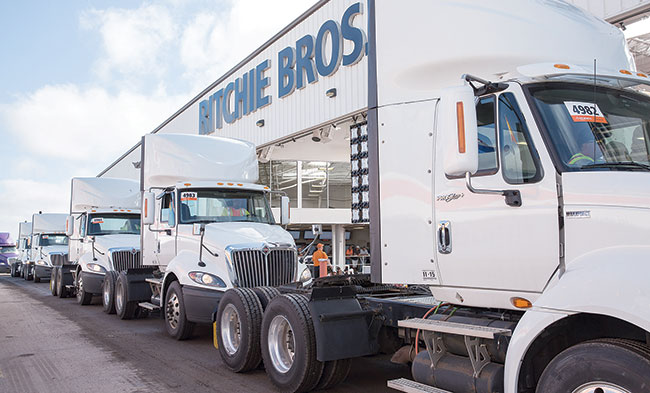August saw a return to a relatively steep depreciation in the price of used Class 8 trucks, according to J.D. Power Senior Analyst & Product Manager Chris Visser, although some of the details are yet to fully materialize.
This came after the second quarter of 2023 saw a bit of a flattening out in the post-pandemic used truck market depreciation, Visser, the architect of J.D. Power’s commercial vehicle valuation and market intelligence processes, told the FTR Transportation Conference 2023.
“The market took a breather” in the second quarter, said Visser, adding that analysts are still trying to fully understand why.
“It could be that values got low enough where supply and demand were in equilibrium to an extent where buyers saw enough value in this lower pricing … and jumped back in to an extent and purchased some trucks,” Visser said.

Visser
August’s return to a steep depreciation, meanwhile, could be due to a second wave of post-pandemic exits hitting the auction market, possibly due to fiscal-year ramifications, he said.
More generally, the factors currently dominating the used truck market include spot rates’ stability, rising amounts of negative equity, interest rates increasing, supply increasing and the new truck backlog being back to normal, said Visser.
Prices are 5% to 10% higher than where they were during the last strong pre-pandemic market of 2018, Visser told the conference, however, with the August acceleration in depreciation, the market is narrowing the spread to the level seen in 2019’s weak market.
Visser said prices for 4- to 6-year-old trucks are down 5.1% year-to-date. Retail prices have depreciated 3.7% so far in 2023, but are currently 11% above the pre-pandemic peak.
Auction prices rose 160% between 2019 and 2022, he said. Retail prices rose 80% to 90% between 2019 and 2022. “All the craziness was on the auction side,” he added.
“Retail pricing is typically stickier than auction and wholesale pricing,” he said, adding: “Retail pricing generally doesn’t correct as quickly or as notably as auction pricing.”
Now, both retail and auction markets are trying to figure out where they want to be, he said.

International trucks up for auction at Ritchie Bros. Visser said that auction volumes have been on the rise since 2019. (Ritchie Bros. Auction)
“I don’t need to tell you that the last couple of years have been the most ridiculous that we’ve seen. Anybody that’s in this industry, it doesn’t matter how old you are, you can’t come up with enough words to describe what happened to the [used truck] market,” he said.
Trucks with less than 350,000 miles on the clock are the hottest commodity in the market at the moment, he said.
There is a dual market at present, said Visser. Vehicles with more than 400,000 miles have seen the biggest depreciation in value and there is a huge overhang of supply, he said.
That is because rigs were doing the work of multiple trucks during the pandemic.
Smaller carriers put 200,000 miles a year on their trucks, leading to 3- or 4-year old rigs coming on the market with up to 800,000 miles on the clock, Visser said.
Visser, who started analyzing the used truck market in the late 1990s, said he had never seen trucks with this amount of mileage at that age before.

Gragg Wilson of UPS won grand champion honors at the National Truck Driving Championships. Wilson takes us through the competition’s course, successful driving practices and how to attract new drivers. Tune in above or by going to RoadSigns.ttnews.com.
Auction volumes have been on the rise since 2019, he said, partly as a result of owner-operators entering the market and then exiting it. He said there had been at least two waves of such trucks coming onto the market.
Used truck values started to spike in mid-2020 as new entrants chased soaring spot rates, said Visser. The market peaked around December 2021-January 2022. There was an equally steep decline on the way down, he said.
In 2022, depreciation was running at 8% on a late-model Class 8 sleeper cab. Typically, depreciation runs at about 2% to 3% a year, he said, depending on whether it is a relatively strong or weak market.
After that, even before Yellow Corp. went out of business, a couple of major nationwide fleet players were offloading considerable numbers of 4- to 6-year-old cabs, said Visser.
Most of Yellow’s fleet is single-axle day cabs, where there is a much better relationship between supply and demand currently, he said.
The trucks that Yellow bought with the $400 million provided by the Department of the Treasury are likely to see a return of $100,000 per unit, said Visser. Even though there are about 2,000 of them, demand should be strong, he added.
Older trucks made up a large percentage of Yellow’s fleet and will only achieve a price of $20,000, although there could be some crossover between demand for single-axle and tandem-axle day cabs, Visser said.
Yellow’s auction of more than 12,000 tractors will be unprecedented in size, but the used truck market can handle it, observers told Transport Topics at the end of August.
A liquidation of this type has not been seen for decades, Stacy Tracy, president of auctioneers Taylor & Martin Inc., said, adding that it was by far the biggest sale by value in the history of the trucking industry.
Yellow ranks No. 13 on the Transport Topics Top 100 list of the largest for-hire carriers in North America.






